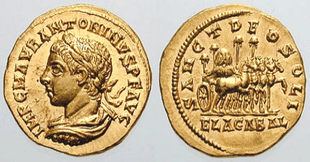Elagabalus (deity)
Elagabalus /ˌɛləˈɡæbə.ləs/, Aelagabalus, or Heliogabalus /ˌhiːliəˈɡæbə.ləs/ is a Syro-Roman sun god. Although there were many variations of the name, the god was consistently referred to as Elagabalus in Roman coins and inscriptions from AD 218 on, during the reign of emperor Elagabalus.[1]
Cult

Elagabalus was initially venerated at Emesa in Syria. The name is the Latinised form of the Semitic Ilāh hag-Gabal, which derives from Ilāh "god" and gabal "mountain" (compare Arabic: جبل jabal), resulting in "the God of the Mountain", the Emesene manifestation of the deity.[2] The cult of the deity spread to other parts of the Roman Empire in the second century. For example, a dedication has been found as far away as Woerden, in the modern-day Netherlands.[3]
In Rome
The cult statue was brought to Rome by the Emperor Marcus Aurelius Antoninus, who, before his accession, was the hereditary high priest at Emesa and was commonly called Elagabalus after the deity.[4]
The Syrian deity was assimilated with the Roman sun god known as Sol Invictus ("the Undefeated Sun").[5]
A temple called the Elagabalium was built on the east face of the Palatine Hill, to house the holy stone of the Emesa temple, a black conical meteorite.[6] Herodian writes of that stone:
This stone is worshipped as though it were sent from heaven; on it there are some small projecting pieces and markings that are pointed out, which the people would like to believe are a rough picture of the sun, because this is how they see them.[7]

Herodian also relates that Elagabalus forced senators to watch while he danced around his deity's altar to the sound of drums and cymbals,[6] and at each summer solstice celebrated a great festival, popular with the masses because of food distributions,[8] during which he placed the holy stone on a chariot adorned with gold and jewels, which he paraded through the city:
A six horse chariot carried the divinity, the horses huge and flawlessly white, with expensive gold fittings and rich ornaments. No one held the reins, and no one rode in the chariot; the vehicle was escorted as if the god himself were the charioteer. Elagabalus ran backward in front of the chariot, facing the god and holding the horses reins. He made the whole journey in this reverse fashion, looking up into the face of his god.[8]
Herodian's description strongly suggests that the Emesene cult was inspired by the Babylonian Akitu-festival.[9]
The Emperor also tried to bring about a union of Roman and Syrian religion under the supremacy of his deity, which he placed even above Jupiter,[10] and to which he assigned either Astarte, Minerva or Urania, or some combination of the three, as wife.[8] The most sacred relics from the Roman religion were transferred from their respective shrines to the Elagabalium, including "the emblem of the Great Mother, the fire of Vesta, the Palladium, the shields of the Salii, and all that the Romans held sacred." He reportedly also declared that Jews, Samaritans and Christians must transfer their rites to his temple so that it "might include the mysteries of every form of worship."[11]
After the Emperor was killed in 222, his religious edicts were reversed and the cult of Elagabalus returned to Emesa.[12]
Literature
- M. Pietrzykowsky, "Die Religionspolitik des Kaisers Elagabal", in: Aufstieg und Niedergang der römischen Welt II 16.3 (1986) 806-1825
See also
References
| Wikimedia Commons has media related to Elagabalus Sol Invictus. |
- ↑ Martijn Icks, The Crimes of Elagabalus: The Life and Legacy of Rome's Decadent Boy Emperor (2011) p. 48
- ↑ Lenormant, Francois (1881). "Sol Elagabalus". Revue de l'Histoire des Religions. 3: 310.
- ↑ An Early Dedication to Elagabal; the inscription is in now in Woerden's city museum.
- ↑ Halsberghe, Gaston H. (1972). The Cult of Sol Invictus. Leiden: Brill. p. 62.
- ↑ Devlaminck, Pieter (2004). "De Cultus van Sol Invictus: Een vergelijkende studie tussen keizer Elagabalus (218-222) en keizer Aurelianus (270-275)" (in Dutch). University of Ghent. Retrieved 2007-08-07.
- 1 2 Herodian, Roman History V.5
- ↑ Herodian, Roman History V.3
- 1 2 3 Herodian, Roman History V.6.
- ↑ M. Geller, "The Last Wedge," in Zeitschrift für Assyriologie 87 (1997), pp. 43-95.
- ↑ Cassius Dio, Roman History LXXX.11
- ↑ Augustan History, Life of Elagabalus 3
- ↑ Herodian, Roman History VI.6